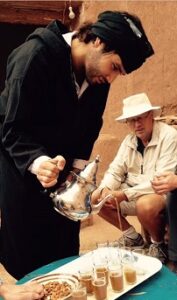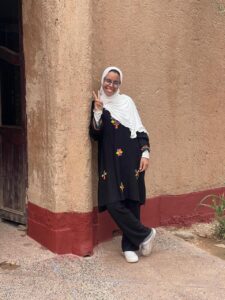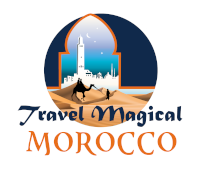Morocco is a land of contrasts. Modern and traditional, modest and vibrant, Western and Islamic. You’ll see it in the streets, in the markets, and in the way people dress. There are no dress codes for tourists — you can wear whatever you want. But what you wear does influence how your journey unfolds, and how people respond to you along the way.
Moroccans like to dress neatly

It’s clear from the moment you walk through a Moroccan street: people pay attention to how they look. Clothes are clean, often ironed, shoes polished, hair tidy — even for a quick trip to the bakery. At the same time, it’s not unusual to see someone shopping in pajamas, especially in local neighborhoods. Those two extremes exist side by side. But one thing is consistent: looking presentable matters.
Appearances can be deceiving: looking neat doesn’t mean wealthy
Someone who looks sharp and well-groomed isn’t necessarily wealthy. In Morocco, dressing neatly isn’t about status — it’s about pride and self-respect. People who have very little may still take great care in their appearance. It’s a form of dignity, and it shapes how people view one another — including how they view you.
Modesty as a cultural value
Morocco is a predominantly Islamic country. While not everyone is religious in the same way, the cultural value of ḥayāʾ— modesty — is widely respected. And that includes how people dress.
For both men and women, this usually means covering the body, choosing loose-fitting clothes, and avoiding anything too flashy or revealing. It’s not about rules or restrictions, but about shared norms rooted in culture, faith, and mutual respect.
What that means for you as a traveler
Tourists won’t be judged or corrected for what they wear. There are no bans or restrictions. But clothing sends a quiet message — whether you realize it or not. If you dress with some awareness of local norms, you’ll often find people more open, helpful, and relaxed around you.
Recommended clothing for tourists
- Cover your shoulders
- Wear pants or skirts that go below the knee
- Avoid deep necklines or see-through fabrics
- Leave beachwear for the beach or pool areas
You don’t need to dress like a local. But if your clothing shows that you’re paying attention to your surroundings, it says: I’m not just passing through — I’m really here.
What you wear can shape your connection with locals
 Moroccans are generally friendly and curious toward visitors. But appearance does affect how people approach you. If you’re dressed neatly and modestly, you’re more likely to be taken seriously — not just as a tourist, but as someone genuinely interested in the place and its people.
Moroccans are generally friendly and curious toward visitors. But appearance does affect how people approach you. If you’re dressed neatly and modestly, you’re more likely to be taken seriously — not just as a tourist, but as someone genuinely interested in the place and its people.
That can make all the difference — between a short chat in the market and an invitation for tea at someone’s home. Clothing isn’t just practical: it opens doors to real encounters.
Outside the cities: consider adjusting even more
When you travel beyond the cities — into the mountains, the desert, or smaller towns — traditional dress is more common. People tend to live more closely to cultural and religious customs, and the contrast with Western tourists becomes more noticeable.
Again, you don’t need to blend in completely. But choosing clothing that’s more in line with the environment helps you feel more comfortable — and helps others feel more comfortable with you. Loose, breathable, and covered works everywhere — and it keeps you cool, too.
Traditional Moroccan clothing: what to recognize
Moroccan traditional clothing is diverse, elegant, and functional — and you’ll see it in many forms across the country.
- Djellaba: A long, loose-fitting robe with long sleeves and a pointed hood, worn by both men and women. It’s used daily in both cities and villages and offers sun protection while staying breathable. Some are simple and made for everyday wear, others are ornate and worn on special occasions.
- Kandoura: A long, loose-fitting garment for men, typically without a hood and simpler in design than the djellaba. Often worn at home or in warm weather. The sleeves are long, and the overall design is practical and comfortable.
- Kaftan: A long, often embroidered gown worn by women, especially at weddings and formal events. It’s elegant, fitted, and considered a traditional piece of festive wear.
- Babouches: Soft, leather slippers with no heel, often brightly colored and handmade. Worn indoors and outdoors, by men and women alike — especially during religious holidays and family gatherings.
You don’t need to wear traditional clothing as a visitor — but knowing what these garments are can enrich your understanding of the culture. And if you’re curious: you’ll find djellabas and babouches for sale at many local souks. They’re often comfortable souvenirs, too.
Shoes off on carpets: small gestures, big impact
In Moroccan homes, riads, and many shops, carpets are more than decoration — they’re living space. People sit, pray, eat,  and rest on them. If you see a carpet, especially in someone’s home or a traditional interior: take off your shoes, unless it’s clear you don’t need to.
and rest on them. If you see a carpet, especially in someone’s home or a traditional interior: take off your shoes, unless it’s clear you don’t need to.
It’s a small gesture, but it says a lot: I see where I am, and I’m adapting to it. That kind of quiet respect leaves an impression.
In summary: What to wear in Morocco: clothing as a bridge to culture
Nothing is required in Morocco, but everything you wear says something. Dressing neatly and modestly isn’t about fear or rules — it’s a conscious choice to engage more deeply with the place and its people.
So about What to wear in Morocco: Your clothing isn’t a detail. It’s an invitation. And it can shape how rich your journey becomes.
